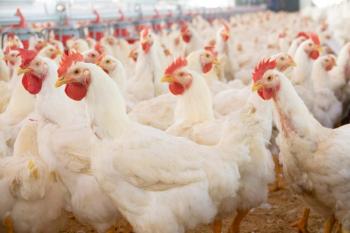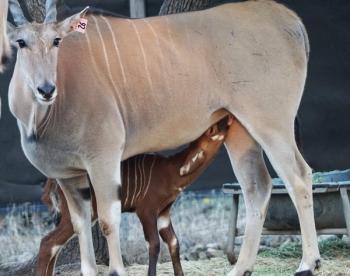
Gastrointestinal stasis in small herbivores (Proceedings)
Rabbits, chinchillas, and guinea pigs are monogastric, hind-gut fermenters; all have a functional cecum and require a high-fiber diet. Fiber is broken down in the cecum by a variety of microorganisms which are nourished by a constant supply of water and nutrients from the stomach and small intestine.
Rabbits, chinchillas, and guinea pigs are monogastric, hind-gut fermenters; all have a functional cecum and require a high-fiber diet. Fiber is broken down in the cecum by a variety of microorganisms which are nourished by a constant supply of water and nutrients from the stomach and small intestine. These same microorganisms produce volatile fatty acids (VFAs) which, in turn, affect appetite and gut motility. Any disturbance in this mutually beneficial relationship can result in gastrointestinal hypomotility—increased GI transit time characterized by decreased frequency of cecocolonic segmental contractions. In severe cases, this leads to ileus with little to no caudal movement of ingesta, known in practice as gastrointestinal stasis.
Pathophysiology
Gastrointestinal stasis is not a disease but a symptom that one or more of the factors governing GI motility are out of order. There are no breed or gender predilections for GI stasis, and it can occur at any age. Proper hind-gut fermentation and GI tract motility are dependent on the ingestion of large amounts of roughage, long-stemmed hay, and water. Diets that contain inadequate amounts of long-stemmed, course fiber predispose the patient to gastrointestinal stasis. Hypomotility of the GI tract can alter cecal fermentation, pH, and substrate production such that enteric microflora populations are altered.
Diets low in course fiber typically contain high simple carbohydrate concentrations, which provide a ready source of fermentable products. This alters the large bowel ecology in a way that threatens favorable microorganisms and promotes bacterial pathogens (e.g. E coli and Clostridium), and toxin production. Bacterial dysbiosis can cause acute diarrhea, chronic intermittent diarrhea, enterotoxemia, ileus, or gas accumulation ("bloat"). As nausea and gastrointestinal discomfort lead to anorexia, fiber and water intake are further reduced, and the process becomes self-perpetuating. If prolonged, GI stasis often leads to hepatic lipidosis, dehydration, and other secondary complications.
Rabbits, guinea pigs, and chinchillas can not vomit. In the healthy digestive tract, a moderate amount of gas is normally produced by the fermentation process and eliminated by peristalsis. With GI stasis, however, there can be excessive gas production and, without normal motility, the stomach and intestines can overfill with gas and become distended, a condition commonly called "bloat".
Etiology
Gastrointestinal stasis is often the result of insufficient dietary fiber and/or excessive stress. It is most commonly associated with inappropriate diet. A diet high in roughage such as grasses and long-stemmed hay is ideal. Rabbits, guinea pigs, and chinchillas that do not receive enough fiber often suffer from subclinical hypomotility, and are thus more susceptible to other risk factors for GI stasis, whereas those that have adequate fiber intake are more resistant.
GI hypomotility is promoted by a diet consisting primarily of commercial pellets, especially those containing seeds, oats, or other high-carbohydrate treats. Feeding cereal products (bread, crackers, and breakfast cereals) and foods high in simple carbohydrates (fruits, yogurt drops, other treats) further increases the risk. Because intestinal microflora depend on a steady flow of water and nutrients, and the digestive tract depends on fiber for normal motility, any event leading to inappetence or anorexia (pre-surgical fasting, sudden changes in the diet, concurrent illness, starvation) or dehydration (sipper malfunction, bad tasting water, careless mistake) can trigger an episode of GI stasis.
Stressful conditions have a negative effect on gut motility. GI motility is regulated in part by the autonomic nervous system; stress increases the adrenal output of epinephrine and inhibits peristalsis. Common causes of stress include dental disease (malocclusion, molar elongation, odontogenic abscesses), metabolic disease (renal disease, liver disease), pain (oral, trauma, postoperative, urolithiasis), anxiety (dyspnea, fear, fighting, lack of hide box), neoplasia, infection, parasitism, and environmental changes (boarding, new pets, unfamiliar noises).
Other factors that can contribute to GI stasis include toxin ingestion, foreign material (scoopable cat litter, hair, carpet fiber), obesity, inactivity, confinement, and certain drugs (anesthetics, anticholinergics, opioids, antibiotics). Inappropriate antibiotics can damage enteric microflora, promote the growth of pathogens associated with GI stasis, and lead to antibiotic-associated enterotoxemia.
Presenting signs
GI stasis is one of the most common presentations seen in small herbivores. Affected animals usually present for decreased appetite; patients will often initially stop eating pellets or hay, but will continue to eat treats, followed later by complete anorexia. Fecal pellets may have become scant, firm, or small in size; with complete GI stasis there may be no fecal production at all. In some cases there may be soft stools or diarrhea. Initially patients are bright and alert, but with prolonged stasis may present depressed, lethargic, or shocky. Signs of pain include bruxism, hunched posture, failure to groom, and reluctance to move. Affected animals may stretch out or roll in an attempt to relieve pain.
Diagnosis
GI stasis should be suspected when there is decreased appetite and/or fecal production, and a recent history of inappropriate diet, illness or stressful event. Abdominal palpation may reveal small, hard fecal pellets or absence of fecal pellets palpable in the colon. The cecum may be filled with gas, fluid, or firm, dry contents depending on the underlying cause. The normal stomach should be easily deformable, soft, and pliable; it should not remain pitted on compression. With complete GI stasis the stomach may be severely distended, hard, and nondeformable. The presence of firm ingesta in the stomach of a patient that has been anorectic for 1-3 days is compatible with the diagnosis of GI stasis. Differential diagnosis includes GI obstruction due to foreign body, volvulus, intusussception, or intestinal neoplasia, and any cause of anorexia and decreased fecal output (e.g. dental disease, metabolic disease, cardiac disease).
CBC, biochemistry and urinalysis are often normal, but may be used to identify underlying causes of GI hypomotility and anorexia. PCV and TS may be elevated with dehydration. Liver parameters may be elevated in cases with hepatic lipidosis. Inflammatory leukogram may be seen with intestinal perforation.
Gastric contents, including hair (rabbits), are normally present and visible radiographically, however, a distended stomach in spite of anorexia implies gastrointestinal stasis. A halo of gas can be observed around the inspisated stomach contents in some cases of GI stasis, and there can be moderate to severe gas distension throughout the digestive tract, including the cecum. Small fecal balls or the absence of fecal balls in the colon is highly suggestive of hypomotility. Severe distention of the stomach with fluid and/or gas is radiographic evidence of acute small intestinal obstruction, which constitutes a surgical emergency.
Treatment
Medical management of GI stasis centers on basic supportive care. Warmth, stress reduction, pain relief, fluid replacement and nutritional support are important first aid measures. The clinician should consider hospitalization in a quiet environment so that the patient can be observed, his progress monitored, and additional nursing care provided as needed. Provide thermal support through the use of incubators, heating pads, or radiant heat emitters; to avoid causing heat stress, ambient temperature should not exceed 80°F. Small herbivores should be housed in a dark, quiet space away from natural predators' noise and odors.
Anxiety can be safely reduced in most rabbits and rodents with injectable midazolam (0.25-0.5 mg/kg SQ or IM). Analgesics such as buprenorphine (0.02-0.05 mg/kg IM, SC q 8-12 hrs) or meloxicam (0.2-0.3 mg/kg IM, SQ, PO q 24 hrs) are essential in most cases as intestinal pain decreases appetite and impairs GI motility.
Parental fluids are typically given SQ at a rate of 25-35 ml/kg q 8 hrs. Warm all parental fluids prior to administration. Although the majority of cases can be treated effectively with subcutaneous fluids, shocky, azotemic, and critically ill patients should receive intravenous fluids. IV catheters can be placed in any site normally used for venipuncture, but the cephalic and saphenous veins are the most practical. In an emergency or when peripheral veins are collapsed, fluids can be administered intraosseously. Provide additional fluid support orally with oral electrolyte solutions such as Rebound OES (Virbac) or Pedialyte (Abbott) at 15-20 ml/kg q 8 hrs. Fluids are continued and then gradually reduced until urine output and drinking return to normal.
Provide nutritional support by syringe-feeding gruel such as Oxbow Critical Care Formula. Additional options include vegetable baby foods and soaked, ground pellets. Feed approximately 20-30 ml/kg q 8 hrs. For prolonged nutritional support, a nasogastric tube can be placed in a manner similar to that used for cats (limited mostly to rabbits and large guinea pigs due to size constraints). Liquid enteral fluids (Ensure, Sustecal), Oxbow Critical Care Fine Grind formula, and diluted vegetable baby food can be passed through an 8fr or even a 5-fr NG tube. Patients should be tempted often with parsley and other fresh greens to see if they will eat on their own. Nutritional support is continued and then gradually reduced until fecal production and appetite return to normal.
Motility modifiers are indicated in cases of GI stasis, bloat, and reduced fecal output, provided intestinal obstruction and perforation have been ruled out. The author usually begins prokinetic therapy with injectable medication in severe cases. Metoclopramide 0.5 mg/kg PO, SC, IM, and cisapride 0.5 mg/kg PO are administered q 8-12 hrs for 3-5 days, until appetite and fecal production return to normal. They may be used in alone or in conjunction. Simethicone 20 mg/kg PO q 8-12 hrs may be indicated in cases of gas distention.
Antibiotics are suggested in cases where GI stasis leads to secondary bacterial overgrowth, as indicated by diarrhea, abnormal fecal cytology, or bloody stool. Broad-spectrum antibiotics such as trimethoprim sulfa (30 mg/kg PO q 12 hrs) or enrofloxacin (15 mg/kg PO q 24 hr) should be selected. If antibiotic-associated enterotoxemia is suspected, it can be treated with metronidazole 20 mg/kg q12h (to treat Clostridium), and cholestyramine (binds bacterial toxins) 2 gm/20cc water, divided q 24 hr PO or by gavage. (Dose cited is for a typical rabbit). Probiotics (lactobacillus, yogurt) are of questionable efficacy, however transfaunation with cecotropes from a healthy individual should be considered.
Because activity promotes GI motility, the patient should be allowed supervised time out of the cage to exercise. Access to a safe grazing area will provide additional fiber and enrichment.
Comments on particular species
Rabbit
Rabbits have a normal gastrointestinal transit time (GITT) of only 4-6 hrs. Muscular contractions of the proximal colon separate fiber and non-fiber gut contents. Indigestible fiber is rapidly passed in the hard feces, while the soluble contents are retained in the cecum for fermentation. The cecum empties its contents periodically, and the fermentation products are consumed directly from the anus (called coprophagy or cecotrophy). This "pseudo-rumination" process for redirection helps in the absorption of previously undigested nutrients and inoculates the gut with essential nutrients.
Gastrointestinal stasis in rabbits is commonly referred to as a "hairball". As a result of their grooming habits, rabbits ingest a considerable amount of hair which dietary fiber normally removes. With GI stasis, fluid and fiber intake decrease and the gastric contents condense to form a semi-solid trichobezoar composed of hair and ingesta. Thus, the presence of a hairball is not a disease, but a consequence of chronic GI hypomotility. Surgery is not necessary in most cases. Fluid therapy and assisted feeding help to rehydrate the trichobezoar and facilitate its breakup. Note that papaya, pineapple juice, and proteolytic enzymes have been shown to be ineffective at dissolving hair.
Rabbits are unable to vomit because the cardia is well developed and the duodenum exits the stomach at an angle such that the pylorus is easily compressed. Gastric emptying may be prevented by gastric distention, compression due to trichobezoar, gas, or hepatomegaly, and lead to the development of bloat. Affected rabbits should receive analgesics and simethicone. Decompression by orogastric tube or transabdominal trocar may also be indicated.
Guinea pig
The normal GITT for cavys is approximately 20 hours. Guinea pigs normally perform coprophagy or cecotrophy many times per day, either directly from the anus, or from the cage floor. As in the rabbit, coprophagy seems to be an important function, although its contribution to the nutritional needs of guinea pigs has not been fully characterized. Cavies require a dietary source of vitamin C (25mg/kg per day). When GI dysfunction leads to inappetence or anorexia, supplemental vitamin C should be given.
Guinea pigs do not adapt readily to changes in type, appearance, or presentation of their food or water. Sudden changes in the diet (including the brand of pellet food or hay) may result in serious GI upset or a self-imposed fast (risk factors for GI stasis). Any changes to the diet must be made very gradually.
Guinea pigs are especially susceptible to antibiotic-associated enterotoxemia. The normal gram-positive gastrointestinal flora are very sensitive to antibiotics. Certain antibiotics (penicillin, ampicillin, chlortetracycline, clindamycin, erythromycin, lincomycin) will destroy the normal microbes and permit the overgrowth of Clostridium and elaboration of its toxins. Affected cavys exhibit anorexia, diarrhea, dehydration, and hypothermia. Treatment has been outlined previously, but may also include chloramphenicol 50 mg/kg PO q 8 hr to suppress further clostridial overgrowth, and refaunation with a slurry of feces from a normal individual.
Chinchilla
Chinchillas have a mean GITT of 12-15 hours. Unlike rabbits and guinea pigs, transit time in the chinchilla is not greatly impacted by a reduction in dietary fiber. Like rabbits and cavys, however, chinchillas produce two types of fecal pellets: nitrogen-rich cecotropes, and nitrogen-poor fecal pellets.
Enterotoxemia from Clostridium, E. coli, Proteus, or Pseudomonas is common. Anorexia and decreased fecal output are early warning signs. Severe cases exhibit ileus, bloat, diarrhea, hair and fecal impaction, and rectal prolapse. Gastric trichobezoars in the chinchilla are associated with fur chewing rather than insufficient dietary fiber.
Chinchillas exhibit constipation more often than diarrhea. Affected individuals strain to defecate, and the few pellets they pass are thin, short, hard, and occasionally blood-stained. Constipation usually responds to the careful addition of fiber and fresh vegetables to the diet, along with mineral oil laxatives. Rectal prolapse, intestinal torsion, intusussception, or impaction of the cecum or colonic flexure can occur with chronic constipation, diarrhea, or gastroenteritis. Impactions may respond to medical treatment (mineral oil enema), but prolapse, intusussception or torsion requires surgery.
Bloat (gastric tympani) is associated with feeding hay that has not matured or is rich in clover, sudden food changes (especially the addition of fresh greens and fruits), and GI inflammation. Affected animals are swollen, lie on their sides, hesitate to stir, and are dyspneic. Treat by decompression either by passing a stomach tube or using a transabdominal needle or trocar.
Prognosis
The expected course and prognosis for GI stasis depends on severity and underlying cause. For mild cases with chronic symptoms due to inappropriate diet, the prognosis is generally excellent to good, and diet correction often leads to complete recovery. For moderately severe, acute cases which require hospitalization, the prognosis is good to fair; the patient usually improves after several days of intensive supportive care, and is discharged for additional care at home. In advanced cases--those that went unnoticed for several days prior to presentation—the prognosis is much worse. Hepatic lipidosis, shock, and other complications frequently make treatment unrewarding. Surgical correction of gastric trichobezoar, if indicated, carries a better prognosis than for surgical treatment of acute intestinal blockage by hair.
Prevention
Gastrointestinal hypomotility (and the myriad problems related to it) can be avoided through strict feeding of diets containing adequate amounts of indigestible coarse fiber (long-stemmed hay) and low simple carbohydrate content, along with access to fresh water. Allow small herbivores sufficient daily exercise, and prevent obesity. Minimize changes in the daily routine that might cause stress in small herbivores, and avoid sudden changes the diet. Be certain that clean water is available at all times, and is presented in a familiar manner (sipper vs. bowl).
Use only broad spectrum antibiotics such as trimethoprim-sulfas, fluoroquinolones, chloramphenicol, aminoglycosides, azithromycin, and metronidazole. Discontinue antibiotics if soft stools or other gastrointestinal signs develop. Use drugs that can depress GI motility with caution in small herbivores. Avoid over-fasting patients prior to surgery, control perioperative pain and stress, and encourage patients to eat as soon as possible following surgery. Be certain that all postoperative patients are eating and passing feces prior to release.
Rabbits, guinea pigs, and chinchillas should receive an annual to semiannual complete physical exam. Weight the animal at every opportunity, and encourage owners to check weight monthly. Diet and husbandry should be reviewed, and regular fecal examinations should be performed. Routine screening for disease (CBC/chemistry, urinalysis, radiographs) establishes an individual baseline and aids in the early detection of disease.
References
Lichtenberger M, Lennox A. Updates and advanced therapies for gastrointestinal stasis in rabbits. Vet Clin Exot Anim 2010;13(3):525-541.
Oglesbee BL. The 5-minute Veterinary Consult: Ferret and Rabbit. Ames, Iowa:Blackwell, 2006.
Mitchell MA, Tully TN, Eds. Manual of Exotic Pet Practice. St.Louis: Elsevier, 2009.
Harcourt-Brown F. Textbook of Rabbit Medicine. Oxford: Butterworth-Heineman, 2002.
Quesenberry K, Carpenter J. Ferrets, Rabbits, and Rodents: Clinical Medicine and Surgery, 2nd Ed. St. Louis: Saunders, 2004.
Newsletter
From exam room tips to practice management insights, get trusted veterinary news delivered straight to your inbox—subscribe to dvm360.






